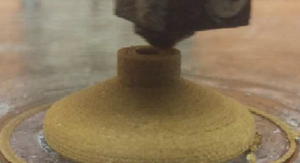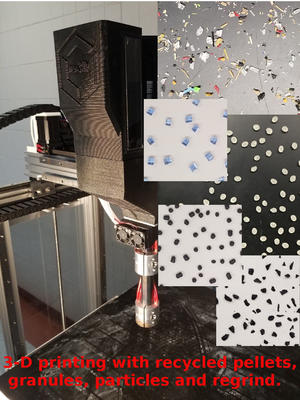
The Michigan furniture industry produces >150 tons/day of wood-based waste, which can be upcycled into a wood polymer composite (WPC). This study investigates the viability of using furniture waste as a feedstock for 3-D printer filament to produce furniture components. The process involves: grinding/milling board scraps made of both LDF/MDF/LDF and melamine/particleboard/paper impregnated with phenolic resins; pre-mixing wood-based powder with the biopolymer poly lactic acid (PLA), extruding twice through open-source recyclebots to fabricate homogeneous 3-D printable WPC filament, and printing with open source FFF-based 3-D printers. The results indicate there is a significant opportunity for waste-based composite WPCs to be used as 3-D printing filament.
- Full open source plans to build a recyclebot
Keywords[edit | edit source]
distributed manufacturing]]; recycling; recyclebot; 3-D printing; polymer filament; wood; wood waste
Post Process[edit | edit source]
Wood Filament Suppliers[edit | edit source]
- https://www.imaginplastics.co.nz/shop/3D+Printing+Filament/Wood-Filled+PLA%3Fcat=00483.html (10% by Weight New Zealand Pine, 90 % INGEO)
- https://www.amazon.com/wood-filament/s?ie=UTF8&page=1&rh=i%3Aaps%2Ck%3Awood%20filament
- https://3dwithus.com/wood-filament
- http://web.archive.org/web/20200807150950/https://woodfilament.com/
- http://www.polymaker.com/shop/polywood/ - wood like but no real wood
- https://3dprintingindustry.com/news/advanced-biocarbon-3d-develops-engineering-grade-wood-based-3d-printer-filament-146227/ - starting from poplar
See also[edit source]
RepRapable Recyclebot and the Wild West of Recycling[edit source]
Recycling Technology[edit source]
- Recyclebot
- RepRapable Recyclebot: Open source 3-D printable extruder for converting plastic to 3-D printing filament
- Open Source 3-D Filament Diameter Sensor for Recycling, Winding and Additive Manufacturing Machines
- Improving recyclebot concepts
- 3-D Printable Polymer Pelletizer Chopper for Fused Granular Fabrication-Based Additive Manufacturing
- Mechanical Properties of Direct Waste Printing of Polylactic Acid with Universal Pellets Extruder: Comparison to Fused Filament Fabrication on Open-Source Desktop Three-Dimensional Printers
- Fused Particle Fabrication 3-D Printing: Recycled Materials' Optimization and Mechanical Properties
- Multi-material distributed recycling via material extrusion: recycled high density polyethylene and poly (ethylene terephthalate) mixture
- Mechanical Properties and Applications of Recycled Polycarbonate Particle Material Extrusion-Based Additive Manufacturing
- Wood Furniture Waste-Based Recycled 3-D Printing Filament
- Solar powered distributed customized manufacturing
- Mechanical Properties of Ultraviolet-Assisted Paste Extrusion and Postextrusion Ultraviolet-Curing of Three-Dimensional Printed Biocomposites
- Open Source Waste Plastic Granulator
- Open-Source Grinding Machine for Compression Screw Manufacturing
- Sustainability and Feasibility Assessment of Distributed E-Waste Recycling using Additive Manufacturing in a Bi-Continental Context
- Finding Ideal Parameters for Recycled Material Fused Particle Fabrication-Based 3D Printing Using an Open Source Software Implementation of Particle Swarm Optimization
- Waste Plastic Direct Extrusion Hangprinter
- Hangprinter for Large Scale Additive Manufacturing using Fused Particle Fabrication with Recycled Plastic and Continuous Feeding
- Open Source Cold and Hot Scientific Sheet Press for Investigating Polymer-Based Material Properties
Distributed Recycling LCA[edit source]
- Tightening the loop on the circular economy: Coupled distributed recycling and manufacturing with recyclebot and RepRap 3-D printing
- Technical pathways for distributed recycling of polymer composites for distributed manufacturing: Windshield wiper blades
- Plastic recycling in additive manufacturing: A systematic literature review and opportunities for the circular economy
- Energy Payback Time of a Solar Photovoltaic Powered Waste Plastic Recyclebot System
- Life cycle analysis of distributed recycling of post-consumer high density polyethylene for 3-D printing filament
- Evaluation of Potential Fair Trade Standards for an Ethical 3-D Printing Filament
- Life cycle analysis of distributed polymer recycling
- Distributed recycling of post-consumer plastic waste in rural areas
- Ethical Filament Foundation
- Green Fab Lab Applications of Large-Area Waste Polymer-based Additive Manufacturing
- Systems Analysis for PET and Olefin Polymers in a Circular Economy
- Potential of distributed recycling from hybrid manufacturing of 3-D printing and injection molding of stamp sand and acrylonitrile styrene acrylate waste composite
- Towards Distributed Recycling with Additive Manufacturing of PET Flake Feedstocks
Literature Reviews[edit source]

- Waste plastic extruder: literature review
- Life cycle analysis of polymer recycling literature review
- Solar powered recyclebot literature review
- Waste plastic extruder: literature review
- Life cycle analysis of polymer recycling literature review
Externals[edit source]
- Economist article on U. of Washington's HDPE boat, Oprn3dp.me
- https://ultimaker.com/en/resources/52444-ocean-plastic-community-project
- Another possible solution - reusable containers [1]
- Commercial https://dyzedesign.com/pulsar-pellet-extruder/
- ---
- Cruz, F., Lanza, S., Boudaoud, H., Hoppe, S., & Camargo, M. Polymer Recycling and Additive Manufacturing in an Open Source context: Optimization of processes and methods. [2]
- Investigating Material Degradation through the Recycling of PLA in Additively Manufactured Parts
- Mohammed, M.I., Das, A., Gomez-Kervin, E., Wilson, D. and Gibson, I., EcoPrinting: Investigating the use of 100% recycled Acrylonitrile Butadiene Styrene (ABS) for Additive Manufacturing.
- Kariz, M., Sernek, M., Obućina, M. and Kuzman, M.K., 2017. Effect of wood content in FDM filament on properties of 3D printed parts. Materials Today Communications. [3]
- Kaynak, B., Spoerk, M., Shirole, A., Ziegler, W. and Sapkota, J., 2018. Polypropylene/Cellulose Composites for Material Extrusion Additive Manufacturing. Macromolecular Materials and Engineering, p.1800037. [4]
- O. Martikka et al., "Mechanical Properties of 3D-Printed Wood-Plastic Composites", Key Engineering Materials, Vol. 777, pp. 499-507, 2018 [5]
- Yang, T.C., 2018. Effect of Extrusion Temperature on the Physico-Mechanical Properties of Unidirectional Wood Fiber-Reinforced Polylactic Acid Composite (WFRPC) Components Using Fused Deposition Modeling. Polymers, 10(9), p.976. [6]
- Romani, A., Rognoli, V., & Levi, M. (2021). Design, Materials, and Extrusion-Based Additive Manufacturing in Circular Economy Contexts: From Waste to New Products. Sustainability, 13(13), 7269. https://www.mdpi.com/2071-1050/13/13/7269/pdf
Literature Reviews[edit | edit source]
- Solar powered recyclebot literature review
- Waste plastic extruder: literature review
- Life cycle analysis of polymer recycling literature review
In the media[edit | edit source]
- Kodin jäte voi pian muuttua leluiksi tai käyttöesineiksi – Tältä näyttää 3d-tulostuksen tulevaisuus, joka mullistaa muovin kierrättämisen -- Helsingin Sanomat
- Filamento de madera 3D a partir del reciclado Impresoras 3D
- Michigan Tech Researchers Recycle Wood Furniture Waste into Composite 3D Printing Material 3D Print 49.1k
- Michigan Tech Forscher recyceln Holzmöbelabfälle zu 3D-Druckmaterial aus Verbundwerkstoffen 3D Ruck
- 密歇根技术研究人员将废弃木制家具回收为复合3D打印材料 3D Imperial
- Researchers use industrial wood-waste to make FDM/FFF wood filament 3D Printing Industry 64.3k
- 美 연구팀, 폐기 목재물로 3D프린터 필라멘트 개발 성공 ZDNet (Korea)12k
- Scientists make 3D printable wood filament from furniture waste Wood Working Network 162k
- Filamento de madera 3D a partir del reciclado Impresoras 3D
- 3D printable wood filament from furniture wood-waste Wood Business Portal
- 10 Eco-Friendly 3D Printing Stories From 2018 3D Print







